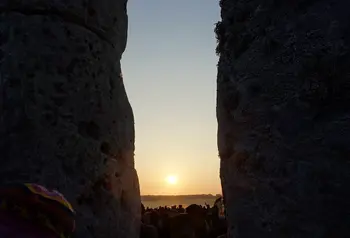How a Stonehenge project helped people's wellbeing

“People in the late Victorian period actually took chisels up to the stones to take samples as souvenirs. Thankfully however this no longer happens or there would be nothing left!”
“It was a magical experience to walk the landscape for 10 weeks with experts treating us all as normal intelligent people, instead of our 'illness'.” – Claire, Human Henge participant
This is one of Simon James Chaplin’s favourite Stonehenge stories and most visitors to the famous stone circle probably share his sentiment, particularly the participants of the Human Henge project.
Human connections
Human Henge, led by the Restoration Trust in partnership with English Heritage, National Trust, Richmond Fellowship and Bournemouth University, was funded by the National Lottery. It enabled Simon and others with mental health issues to improve their wellbeing using the Stonehenge landscape. They took part in singing and craft activities, learnt about archaeology or simply spent time walking and talking to each other.
For Simon it was a chance to explore a local landmark for the first time and in a way that would help him. “Oddly, although I have lived in Wiltshire since I was two and a half, I had never actually visited Stonehenge before,” he says. “Ecotherapy and getting involved in craft projects and music had helped with my mental health problems in the past.”
“Human Henge was an important part of my life, it allowed me to reconnect with myself and meet new people,” says fellow participant Mr BPD (an alias).
For Claire it was a chance to feel normal. “It was a magical experience to walk the landscape for 10 weeks with experts treating us all as normal intelligent people, instead of our 'illness'.”
Lasting impact
“For me the stories I hold most dear from the project are the ones created afterwards such as sharing my birthday with Human Henge friends playing bingo. I normally spend birthdays alone.” – Mr BPD, Human Henge participant
The project has now finished, but many of the group remain friends and the lasting impact of their involvement is clear.
“I have reconnected with my love of history, prehistory and archaeology. I have got in touch with my inner child, regaining a joy at the wonder of the world and ancient landscape,” says Simon, “Stonehenge and the wider landscape will always hold happy memories for me now.”
Mr BPD said: “For me the stories I hold most dear from the project are the ones created afterwards, such as sharing my birthday with Human Henge friends playing bingo. I normally spend birthdays alone.”
Sparking change
Many in the group used their experiences to make changes in their lives and to help others with mental health issues.
Simon became an unofficial spokesperson for Human Henge, sharing his experiences and the importance of the project on local television and BBC Radio 4.
Simon explains: “Such projects not only benefit the participants but also wider society. [They] are a genuine example of care in the community and are a great help in the fight against social isolation.”
Since taking part in the project, Mr BPD has set up the TUG Trowbridge Service Users Group, a mental health drop-in with art classes and music therapy.
To National Lottery players, he adds: “You’re not the only one that wins!”
National Lottery success for Stonehenge
As well as Human Henge, the National Lottery has invested £10million into transforming the site for visitors. 2018 marks 100 years since Cecil Chubb, a local barrister who had bought the ancient monument at an auction, gave it into public ownership.

